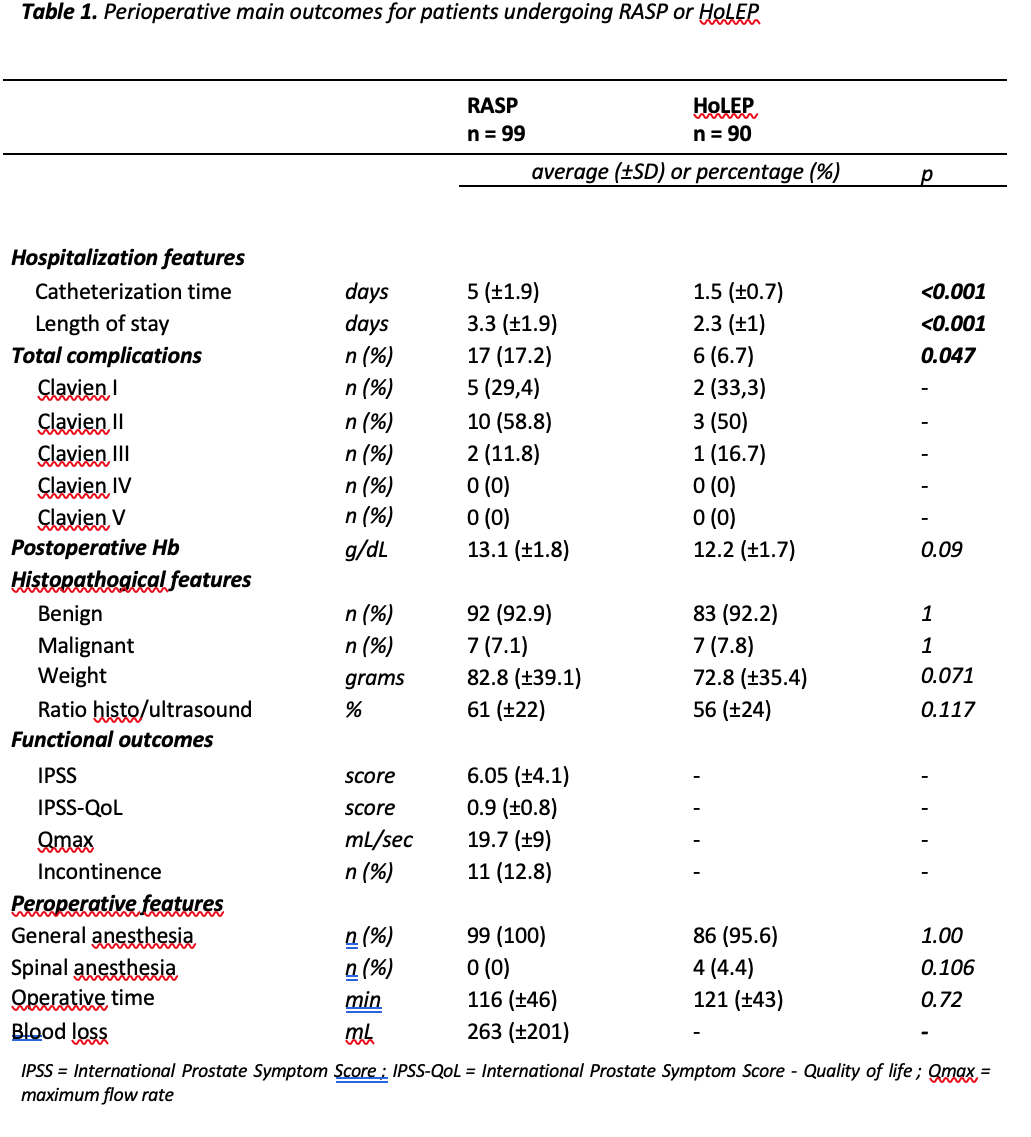Back
Poster, Podium & Video Sessions
MP04: Benign Prostatic Hyperplasia: Surgical Therapy & New Technology II
MP04-18: Robot-assisted simple prostatectomy versus holmium laser enucleation for large prostate glands (>100mL): complications and perioperative outcomes
Friday, May 13, 2022
8:45 AM – 10:00 AM
Location: Room 228
Louis Vignot*, Nice, France, Julien Anract, Paris, France, Imad Bentellis, Nice, France, Albert Semaan, Paris, France, Fabrizio Sartorio, Brannwel Tibi, Youness Ahallal, Nice, France, Michael Peyromaure, Paris, France, Daniel Chevallier, Nice, France, Nicolas Barry Delongchamps, Paris, France, Matthieu Durand, Nice, France
- LV
Poster Presenter(s)
Introduction: Robot-assisted simple prostatectomy (RASP) and Holmium laser enucleation of the prostate (HoLEP) are two different mini-invasive surgical techniques for the management of large prostate adenomas. We aimed to compare the early postoperative complications and the predictive factors of complications, as well as the perioperative results between these two techniques.
Methods: A retrospective multicentric comparative study between two cohorts was performed on all patients operated between January 2018 and December 2020. Inclusion criteria were age > 45 years, lower urinary tract symptoms (LUTS) with surgical indication.
Results: A total of 360 patients were included, 171 excluded and 189 analyzed with a prostate volume > 100mL, 99 RASP and 90 HoLEP. The two groups were comparable overall with an initial prostate volume of 133.3 mL for the RASP group and 130.4 mL for the HoLEP group (p = 0.56). The early complication rate was 17.2% and 6.7% for the RASP and HoLEP groups, respectively (p = 0.047), and multivariate analysis did not reveal any predictive factor for complication. Mean length of hospitalization (3.3 days vs. 2.3 days) and catheterization time (5 days vs. 1.5 days) were significantly lower for the HoLEP group (p < 0.001). The rate of prostate cancer detection (7.1% vs 7.8%) was comparable between the RASP and HoLEP groups (Table 1).
Conclusions: Our study revealed a lower complication rate in the HoLEP group for high-volume adenomas (>100 mL) without demonstrating a predictive factor for the occurrence of complications. The average length of stay and the duration of the catheter were lower for the HoLEP group. RASP remains a safe and effective technique with a majority of low-grade complications and a significant improvement of functional urinary parameters. A more comprehensive study integrating the experiences of the center and the operators would be interesting to corroborate these results.
Source of Funding: None

Methods: A retrospective multicentric comparative study between two cohorts was performed on all patients operated between January 2018 and December 2020. Inclusion criteria were age > 45 years, lower urinary tract symptoms (LUTS) with surgical indication.
Results: A total of 360 patients were included, 171 excluded and 189 analyzed with a prostate volume > 100mL, 99 RASP and 90 HoLEP. The two groups were comparable overall with an initial prostate volume of 133.3 mL for the RASP group and 130.4 mL for the HoLEP group (p = 0.56). The early complication rate was 17.2% and 6.7% for the RASP and HoLEP groups, respectively (p = 0.047), and multivariate analysis did not reveal any predictive factor for complication. Mean length of hospitalization (3.3 days vs. 2.3 days) and catheterization time (5 days vs. 1.5 days) were significantly lower for the HoLEP group (p < 0.001). The rate of prostate cancer detection (7.1% vs 7.8%) was comparable between the RASP and HoLEP groups (Table 1).
Conclusions: Our study revealed a lower complication rate in the HoLEP group for high-volume adenomas (>100 mL) without demonstrating a predictive factor for the occurrence of complications. The average length of stay and the duration of the catheter were lower for the HoLEP group. RASP remains a safe and effective technique with a majority of low-grade complications and a significant improvement of functional urinary parameters. A more comprehensive study integrating the experiences of the center and the operators would be interesting to corroborate these results.
Source of Funding: None


.jpg)
.jpg)